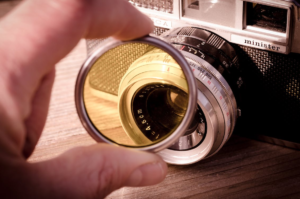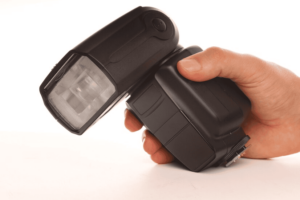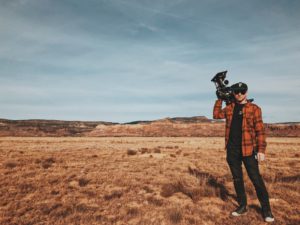A Steadicam operator needs to know how to operate a camera that is simultaneously agile and smooth moving. This type of camera operator works on a film or television set and physically handles the Steadicam, a special camera that maximizes freedom of movement at the same time that it minimizes the camera’s shakiness. In addition to television and film, Steadicam operators may work on talent shows and sports.
Typically, a Steadicam operator comes into the role as a trained, experienced camera operator. This role requires a lot of specialized skill.
Steadicam technology rapidly changes, so if you’re interested in becoming a Steadicam operator, you’ll need to be ready to keep learning as you go along. Learning basic still photography skills is also a good starting point as it teaches you visual and composition skills.
What Does a Steadicam Operator Do?
Steadicams are the reason professional films don’t look shaky like your typical home movie. Like other camera operators, you’ll collaborate with everyone from the director to the director of photography to the actors while you set up and film scenes. You can work on everything from movies to documentaries to TV shows as well, so you’ll need in-depth knowledge of cinematography and photography, not to mention choreography, so you know your shots are in focus, clear, and shot the correct way.
However, a Steadicam operator plays a unique role on any film shoot. Unlike other camera operators, a Steadicam operator must fulfill a physical role. That’s because traditional cameras are mounted on camera dollies that dolly grips move along tracks, but a Steadicam uses its operator as its mount.
As a Steadicam operator, you’ll have the camera connected to you with a special body harness that restricts your own movements. This brings the fluidity a handheld camera offers together with a dolly shot’s stability. In turn, this allows to you track the movements of actors and other objects more easily. On screen, you’ll get a steady shot, but this requires any Steadicam operator to spend the day lifting, stretching, and positioning yourself and the camera just as much as you actually film.
Tips for Becoming a Successful Steadicam Operator
Practice, practice, and more practice will help you become a great Steadicam operator. Here are some other important things to know about the role.
Learn the Parts of a Steadicam
A Steadicam has a few main parts:
- Arm: The arm acts as an extension of the Steadicam operator’s body. It provides the connection to the sled and stabilizes all movements. The Steadicam arm usually has two main segments that springs support.
- Sled: The sled is a vessel that comes together with a camera rig. It needs to balance on a gimbal to achieve what’s known as dynamic balance. The sled includes:
- Arm
- Battery rack
- Gimbal
- Monitor
- Top stage
- Vest: By connecting your body to the arm, which in turn connects to the sled, the Steadicam vest lets the momentum and weight of the rig fall on your body. Your body offers more power than just your arms.

Scene from “Aliens”
Understanding Balance and Drop Time
A sled has to get a neutral balance at the point of the gimbal. That way, the camera floats without effort when there’s lateral movement.
You will need to first position the following on your sled to achieve dynamic balance:
- Accessories
- Camera
- Gimbal
- Monitor
- Power
You’re trying to get all elements on the top and bottom to balance with the adjustable gimbal.
Drop time is another key factor. Drop time is the amount of time the sled takes to drop on the gimbal from horizontal to vertical. Typically the best options for flying come when you get a drop time of around three seconds.
Let the Rig Do the Work When You’re Flying
Flying a rig is easier than you might imagine. You just strap on your vest, attach the arm to your vest, and throw the sled on the arm. Then, you put one hand on the gimbal arm while feathering the gimbal grip with the other hand.
When you’re just starting out as a Steadicam operator, you’ll want to fight your instincts to try to control the rig and just let it do its own work. The best way to understand how this works is simply to try it out.
Diligently Work on Your Skills
As the Steadicam is a tool, it doesn’t help if you don’t know how to use it correctly. You can read the Steadicam Operator’s Handbook for great insight. Finding a mentor and taking a class to develop the right habits, then practice and keep on practicing.
Invest in Gear
Becoming a Steadicam operator does take great investment when you’re first starting out. Steadicams are quite expensive. Still, you need the right Steadicams and rigs to do your job as a Steadicam operator effectively. Try out a less expensive rig to make sure you enjoy the work, as Steadicam operators make a big commitment.
How to Become a Steadicam Operator
If you want to be a Steadicam operator, you’ll need to have a strong working knowledge of all camera lenses and systems. You will also need to keep your knowledge of available Steadicam and body mount systems current. As a Steadicam operator, you’ll need to know about available accessories like video senders and receivers and remote focus systems as well as specialized equipment. Steadicam operator is a physically demanding role, so it’s helpful if you’re also knowledgeable about positioning and stretch techniques so you can prevent yourself from getting hurt.
Who Does a Steadicam Operator Work With?
Steadicam operators work with many people on a project, including:
- Camera teams
- Directors
- Directors of photography
- Location and studio production crews
- Producers
- Production managers
- Steadicam assistants
- Talent and cast
- First assistant camera
- First assistant director
A Steadicam operator will liaise with the director of photography, or DoP, as well as the director and actors as they set up and perform the needed shots. Steadicam operators also work with the first assistant camera to make sure shots are in focus. Finally, Steadicam operators work with the first assistant director to ensure the choreography of a shot goes smoothly.
What Is the Career Path to Become a Steadicam Operator?
You must first become an experienced camera operator before becoming a Steadicam operator since the role requires such specific skill. Most camera operators gain their skills through on-the-job industry positions. Once you’re an experienced camera operator, you can find specialist Steadicam courses to hone your skills.
Is the Role Right for You?
To work as a Steadicam operator, you need to:
- Be an experienced, highly skilled camera operator
- Be able to collaborate closely with a director to deliver a project’s creative vision
- Have extensive technical knowledge of operating broadcast cameras and their equipment
- Have great skills when working with color
- Have significant stamina and physical strength, since you’ll wear necessary heavy equipment for a long time each day
- Be able to work long days in challenging locations
- Be comfortable traveling for longer periods of time
You’ll find a variety of resources for Steadicam operators out there, as well as resources for when you’re looking for jobs. You can learn more by checking out what a real Steadicam operator has to say, too.
You can learn more about film and how you can improve your skills by applying to the Nashville Film Institute here.













